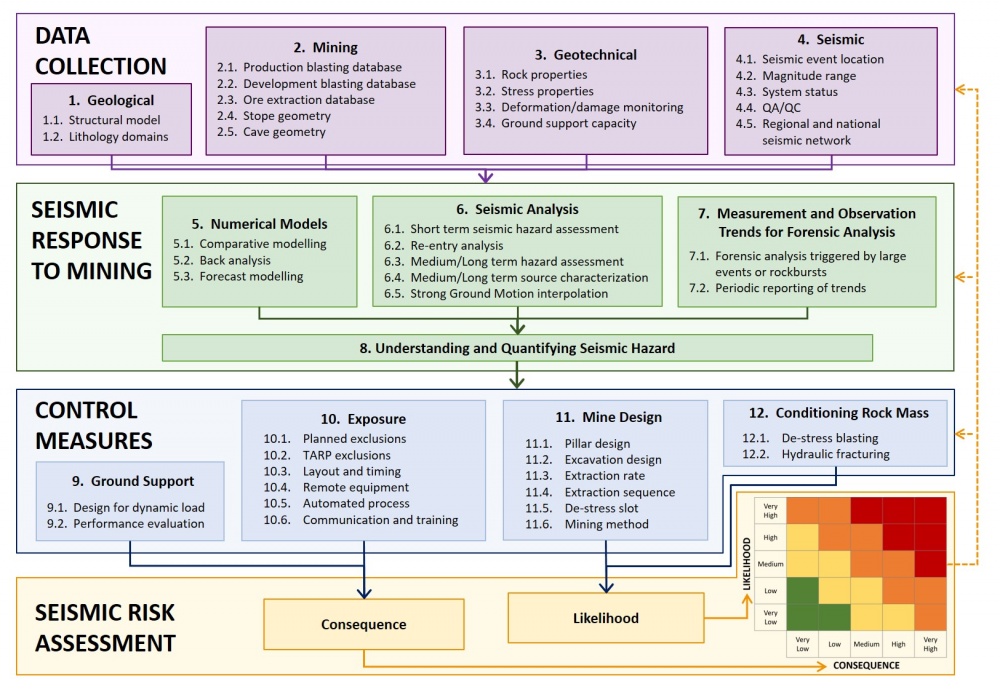Home: Difference between revisions
No edit summary |
No edit summary |
||
| Line 35: | Line 35: | ||
Welcome to the Seismic Risk Management Process Website. This website provides a summary of Seismic Risk Management Practices in hard rock mines and was developed by the [http://www.acg.uwa.edu.au Australian Centre for Geomechanics] (ACG) with the financial support of [http://www.newcrest.com.au Newcrest Mining Limited] (Newcrest). | Welcome to the Seismic Risk Management Process Website. This website provides a summary of Seismic Risk Management Practices in hard rock mines and was developed by the [http://www.acg.uwa.edu.au Australian Centre for Geomechanics] (ACG) with the financial support of [http://www.newcrest.com.au Newcrest Mining Limited] (Newcrest). | ||
<div align="center">[[Seismic Risk Management Process:About|About the SRMP website]]</div> | |||
== About the Flowchart == | |||
This Seismic Risk Management Practices flowchart has been developed and verified during the benchmarking exercise. The process has four major activities, each represented by a coloured area in the flowchart: | |||
<li>Data collection (purple)</li> | |||
<li>Seismic response to mining (green)</li> | |||
<li>Control measures (blue)</li> | |||
<li>Seismic risk assessment (orange)</li> | |||
Within each activity, there are a number of components, represented by boxes in the flowchart. Within each box, a number of practices have been benchmarked and will be discussed in terms of being a “basic” or an “advanced” practice. | |||
== Practice Levels == | |||
Keeping in mind that the goal of the project was to define “best practices” in managing seismic hazard, it is also important to realise that best practice at a mine site is necessarily a function of the intensity of the seismic problem at that site. As such, it is not always necessary nor “best practice” for mines experiencing low seismic hazard to implement extensive and advanced seismological analyses. Hence low, medium and severe seismic hazard will call for different “best practices”. | |||
To circumvent this issue, in this benchmarking report, we will refer to basic and advanced practices. Basic practices indicate approaches commonly used at most mine sites. Advanced practices involve techniques that are uncommon due to: | |||
<li>requiring personnel with a high skill base; and</li> | |||
<li>being labour/computing/time intensive.</li> | |||
Revision as of 15:05, 13 November 2018

Welcome to the Seismic Risk Management Process Website. This website provides a summary of Seismic Risk Management Practices in hard rock mines and was developed by the Australian Centre for Geomechanics (ACG) with the financial support of Newcrest Mining Limited (Newcrest).
About the Flowchart
This Seismic Risk Management Practices flowchart has been developed and verified during the benchmarking exercise. The process has four major activities, each represented by a coloured area in the flowchart:
Within each activity, there are a number of components, represented by boxes in the flowchart. Within each box, a number of practices have been benchmarked and will be discussed in terms of being a “basic” or an “advanced” practice.
Practice Levels
Keeping in mind that the goal of the project was to define “best practices” in managing seismic hazard, it is also important to realise that best practice at a mine site is necessarily a function of the intensity of the seismic problem at that site. As such, it is not always necessary nor “best practice” for mines experiencing low seismic hazard to implement extensive and advanced seismological analyses. Hence low, medium and severe seismic hazard will call for different “best practices”.
To circumvent this issue, in this benchmarking report, we will refer to basic and advanced practices. Basic practices indicate approaches commonly used at most mine sites. Advanced practices involve techniques that are uncommon due to:

